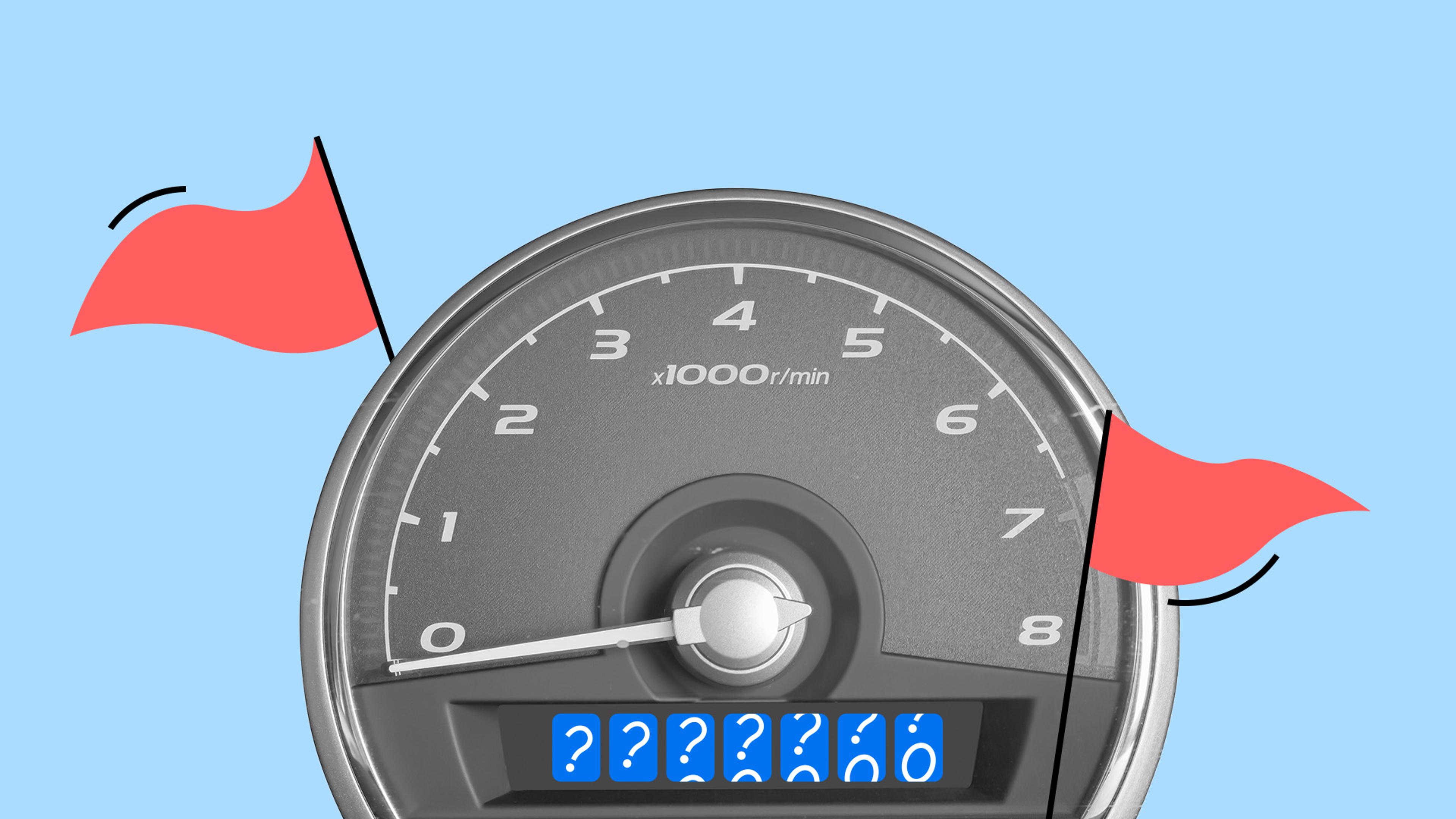10/12/2024
What mileage can tell you about a car

Car mileage is an important indicator that can give you valuable insights about a vehicle’s condition. For this, it's critical to know how to break down the data you’re looking at in the most sensible way.
carVertical is committed to uncovering the truth behind a car's mileage, helping you quickly discover possible signs of odometer fraud and other issues.
Read on to understand what’s going on behind the mileage curves, and how they can help you make a decision when buying a used car.

Need help buying a used car?
Enter a VIN code to learn more about any vehicle!
What is car mileage?
A car’s mileage indicates the total distance a vehicle has traveled throughout its lifespan and is commonly measured in kilometers or miles.
It’s recorded by the car's odometer, which has numbers visible on the dashboard, typically located around the speedometer area. This data is usually recorded on occasions such as registration, during regular maintenance or repairs, vehicle inspections, and when changing ownership.
How does mileage affect a car?
A vehicle’s condition is significantly influenced by the distance it has traveled over time. Here’s how mileage affects different aspects of a car:
- Wear and tear. Typically, a higher mileage indicates that important parts such as the engine, transmission, and suspension have experienced increased usage, potentially resulting in greater wear and tear.
- Maintenance needs. Mileage is crucial for a car's maintenance schedule, like oil changes every 5,000–10,000 km and brake replacements every 30,000–70,000 km. If you neglect mileage-based maintenance, it can lead to reduced performance, costly repairs, safety risks, and a shorter lifespan for your vehicle.
- Resale value. Well-maintained vehicles with lower mileage are usually sold for higher prices due to the assumption they have undergone less wear and tear over time.
It's worth noting that just having a lower mileage doesn’t always mean a better car. Other factors can play a significant role, such as the driving conditions (city vs. highway miles), periods of inactivity when the car wasn’t used, or maintenance history are all equally important. It's a good idea to judge odometer readings while looking at the overall picture.
How to interpret odometer readings
In general, it’s better to have odometer readings taken at regular intervals, as it can confirm that a car has been used on a regular basis and is potentially well maintained. Looking closely at mileage data can also reveal possible issues, such as possible odometer fraud or periods of inactivity.
Mileage drops (or mileage rollbacks) indicate an attempt at deception
Spotting a decrease in mileage between two recorded entries generally indicates that the vehicle's odometer has been tampered with.
Rolling back the odometer to reduce the mileage on a vehicle is known as odometer fraud. It is performed to make a car appear less used than it actually is, in order to increase its market value artificially.
Purchasing a car that has undergone this practice comes with higher risk as it conceals the actual wear and tear and could potentially lead to unexpected (and expensive!) repairs.
Unexplained mileage gaps often point to missing service records
Large gaps between two mileage entries indicate missing records. This can pose risks to buyers, such as undisclosed damages, lack of regular maintenance, or uncertain usage patterns.
Check out this example from a carVertical report on a BMW X Series (2018 model year):
The report shows that it has two mileage records – one from 2018, when it was first used, and the other one four years later.
The missing information in the mileage logs could indicate times when the car may not have been taken for maintenance at authorized centers, or when records were not accurately recorded. This might create difficulties in accurately assessing the car's true condition.
Stagnation in the car’s mileage often indicates limited use
Mileage stagnation happens when the car's mileage stays the same over a longer period of time. This situation could lead to worries regarding possible mechanical issues, accidents, poor maintenance, or challenges in selling the vehicle.
For example, looking at the following data for an Opel Astra (2013) shows an inactivity period from December 2013 to April 2015:
Meanwhile, the Damage section of the carVertical report reveals that the car had an accident in August 2013, valued between €1,501 and €3,000:
This “idle” zone, when looking at mileage readings following the accident, could suggest that perhaps the car may have been at the mechanic for repairs, or potentially undrivable in a garage somewhere. Matching up any mileage data with damage history is a crucial step in understanding a car’s history.
Low mileage is not always a good sign
By using carVertical reports, it’s possible to confirm the average mileage of the model you're interested in, helping you get a better idea of what to expect:
If you find out that the car you're interested in has a lower mileage than the average, a good idea to consider why it hasn’t been used as much. While it may have been well-preserved, there’s also a chance it could have sat undriven for a long time, which often leads to problems such as fluids and seals becoming degraded.
Car mileage vs. age: understanding the connection
The age of a car is often strongly aligned with its mileage, and it’s probably not surprising that the older a car is, the higher its mileage is more likely to be.
Having said that, age and mileage don't always line up perfectly. Being able to understand how their connection can differ goes a long way to helping buyers make better decisions.
- Low mileage for car age: It’s possible the car wasn’t used much or perhaps for shorter trips. Although reduced wear could be positive, longer periods of inactivity might lead to mechanical problems, such as battery degradation or tire flat-spotting.
- High mileage for car age: This can mean regular long-distance driving took place. It isn't always negative, especially if the car was mainly driven on motorways, which is less stressful on parts than city driving.
However, our research has shown that older cars are much more at risk of being clocked. This graph shows how clear the connection is between car age and odometer fraud:
Therefore, always be cautious when dealing with cars with unusually low mileage, as this could suggest that the mileage has been rolled back. Verifying the mileage with reliable sources is crucial to ensuring a good deal.
Not all car makes handle mileage in the same way
Car companies design and build cars with various degrees of durability, and this can often affect how well a car can handle a higher or lower mileage. For example, Toyota consistently ranks among the most reliable car brands, and cars like these might have higher mileage, gaining more kilometers before their owners sell them.
Looking at our research on average mileage by brand, some makes, in particular, are more likely to have higher mileage – mainly due to how much longer they last or how much owners place trust in the vehicle's reliability.
Therefore, sometimes it makes sense to choose a quality brand car with more miles under its belt over a less reputable one with fewer kilometers. The comprehensive information in a carVertical history report can help you better understand the condition of such a car.
High mileage calls for extra attention to possible underlying issues
Although the mileage doesn't always increase the likelihood of finding an accident, you should note that cars with higher mileage may show signs of cumulative damage or/or perhaps previous repairs.
Looking at this carVertical report, you can see a Mercedes-Benz 220 (2020 model year) with a last known mileage of 252,451 km – a notably high figure for a four-year-old car:
There are also two damage records valued between €1,501 and €5,000:
On top of these, the car's timeline shows changes in country, ownership transfers, and new attempts to sell, which can indicate issues:
This grouped example clearly shows how a higher mileage, when looked at with the vehicle’s damage history and frequent ownership changes, could mean the car has underlying issues. Combining multiple aspects of data is essential to get a better outlook on a car before making a purchase.
What is a good mileage for a used car?
On average, a vehicle can run up around 15,000 to 20,000 kilometers per year. In such a case, a 5-year-old car might typically have between 75,000 and 100,000 kilometers on the odometer.
However, you should note that different types of vehicles often accumulate mileage quite differently:
- SUVs and trucks: As they are typically used for longer trips or commercial purposes, they could have a higher mileage.
- Sedans and compact cars: These often show lower mileages, mainly due to shorter, city commuting patterns.
Understanding these indicators can give you a better grasp of whether a car's mileage correctly matches both its age and type.
What is considered high mileage?
There isn’t a clear answer to this, but a car which has more than 200,000 kilometers is usually thought of as high mileage.
Our research shows that average annual mileage can even vary depending on the country, too. For example, in the USA, drivers often drive longer distances over a year than drivers in the EU.
By taking in the overall picture, such as the car's make, model, maintenance history, and driving conditions, buyers can truly understand whether the high-mileage car they’re interested in is worth the cost.
Remember, a "high mileage" car doesn't always mean it's a poor choice, but closely looking at the mileage along with the car’s overall history is crucial.
How to verify car mileage and get the best deal with carVertical
To make sure you're investing wisely, it’s important to verify the accuracy of a car's mileage with carVertical.
In the Odometer section, you can find mileage records throughout the vehicle's history. The report features an interactive graph illustrating any mileage rollbacks, gaps, stagnation, or other inconsistencies.
One more method to identify odometer fraud is by looking at the Title check section (for cars used or previously registered in the US). This section of the report lists odometer brands and can help you identify if the reading displayed on the odometer does not reflect the actual mileage and, therefore, should not be relied on:
Extra details included in the carVertical report are (depending on data availability):
- Damage history: Showing details related to accidents and damage sustained
- Historical photos: Images showing the vehicle over time
- Financial and legal status: Data on possible outstanding debts or legal issues
- Market value: Average price estimates helping you judge the asking price
- Stolen vehicle check: Alerts if the car has been reported stolen
By using this data together with odometer mileage, you can make confident steps towards a purchase decision while avoiding any potential issues down the line.

Check your VIN
Avoid costly problems by checking a vehicle's history. Get a report instantly!
